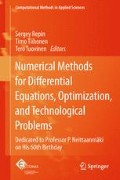Abstract
In this survey contribution, we present and compare, from the viewpoint of adaptive computation, several recently published error estimation procedures for the numerical solution of biharmonic and some further fourth order elliptic problems mostly in 2D. In the hp-adaptive finite element method, there are two possibilities to assess the error of the computed solution a posteriori: to construct a classical analytical error estimate or to obtain a more accurate reference solution by the same procedure as the approximate solution and, from it, the computational error estimate. For the lack of space, we sometimes only refer to the notation introduced in the papers quoted. The complete hypotheses and statements of the theorems presented should also be looked for there.
Access this chapter
Tax calculation will be finalised at checkout
Purchases are for personal use only
References
Ainsworth M, Oden JT (2000) A posteriori error estimation in finite element analysis. Wiley, New York
Babuška I, Rheinboldt WC (1978) Error estimates for adaptive finite element computations. SIAM J Numer Anal 15(4):736–754
Babuška I, Rheinboldt WC (1978) A posteriori error estimates for the finite element method. Int J Numer Methods Eng 12(10):1597–1615
Babuška I, Strouboulis T (2001) The finite element method and its reliability. Clarendon Press, New York
Babuška I, Whiteman JR, Strouboulis T (2011) Finite elements. An introduction to the method and error estimation. Oxford University Press, Oxford
Beirão da Veiga L, Niiranen J, Stenberg R (2007) A posteriori error estimates for the Morley plate bending element. Numer Math 106(2):165–179
Brezzi F, Raviart PA (1977) Mixed finite element methods for 4th order elliptic equations. In: Miller JJH (ed) Topics in numerical analysis III: proceedings of the royal Irish academy conference on numerical analysis. Academic Press, London, pp 33–56
Charbonneau A, Dossou K, Pierre R (1997) A residual-based a posteriori error estimator for the Ciarlet-Raviart formulation of the first biharmonic problem. Numer Methods Partial Differ Equ 13(1):93–111
Ciarlet PG (1978) The finite element method for elliptic problems. North-Holland, Amsterdam
Ciarlet PG, Raviart P-A (1974) A mixed finite element method for the biharmonic equation. In: de Boor C (ed) Mathematical aspects of finite elements in partial differential equations. Proceedings of a symposium conducted by the mathematics research center, the university of Wisconsin–Madison, April 1–3, 1974. Academic Press, New York, pp 125–145
Karátson J, Korotov S (2009) Sharp upper global a posteriori error estimates for nonlinear elliptic variational problems. Appl Math 54(4):297–336
Liu K, Qin X (2007) A gradient recovery-based a posteriori error estimators for the Ciarlet-Raviart formulation of the second biharmonic equations. Appl Math Sci 1(21–24):997–1007
Neittaanmäki P, Repin S (2004) Reliable methods for computer simulation: error control and a posteriori estimates. Elsevier, Amsterdam
Pomeranz SB (1995) A posteriori finite element method error estimates for fourth-order problems. Commun Numer Methods Eng 11(3):213–226
Rannacher R (1979) On nonconforming and mixed finite element method for plate bending problems. The linear case. RAIRO Anal Numér 13(4):369–387
Repin S (2008) A posteriori estimates for partial differential equations. Walter de Gruyter, Berlin
Segeth K (2010) A review of some a posteriori error estimates for adaptive finite element methods. Math Comput Simul 80(8):1589–1600
Vejchodský T (2006) Guaranteed and locally computable a posteriori error estimate. IMA J Numer Anal 26(3):525–540
Verfürth R (1996) A review of a posteriori error estimation and adaptive mesh-refinement techniques. Wiley-Teubner, Stuttgart
Wang M, Zhang W (2008) Local a priori and a posteriori error estimate of TQC9 element for the biharmonic equation. J Comput Math 26(2):196–208
Acknowledgements
This research was supported by the Grant Agency of the Academy of Sciences of the Czech Republic under Grant IAA100190803 and by the Academy of Sciences of the Czech Republic under Research Plan AV0Z10190503 of the Institute of Mathematics.
Author information
Authors and Affiliations
Corresponding author
Editor information
Editors and Affiliations
Rights and permissions
Copyright information
© 2013 Springer Science+Business Media Dordrecht
About this chapter
Cite this chapter
Segeth, K. (2013). On the Advantages and Drawbacks of A Posteriori Error Estimation for Fourth-Order Elliptic Problems. In: Repin, S., Tiihonen, T., Tuovinen, T. (eds) Numerical Methods for Differential Equations, Optimization, and Technological Problems. Computational Methods in Applied Sciences, vol 27. Springer, Dordrecht. https://doi.org/10.1007/978-94-007-5288-7_8
Download citation
DOI: https://doi.org/10.1007/978-94-007-5288-7_8
Publisher Name: Springer, Dordrecht
Print ISBN: 978-94-007-5287-0
Online ISBN: 978-94-007-5288-7
eBook Packages: EngineeringEngineering (R0)

